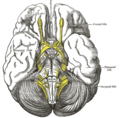Optic chiasma facts for kids
The optic chiasm (pronounced: OP-tik KY-az-um) is a very important part of your brain. It's where the special "wires" from your eyes, called optic nerves, meet and partially cross over. Think of it like a major highway intersection for your vision!
This crossing point is located at the very bottom of your brain, right under a small area called the hypothalamus.
How Your Vision Information Crosses
Your eyes see the world, but the information needs to get to your brain to make sense of it. Each eye has a light-sensitive layer at the back called the retina. The retina collects images.
- The information from the inner (nasal) side of each retina crosses over to the opposite side of your brain at the optic chiasm.
- The information from the outer (temporal) side of each retina stays on the same side of your brain.
This clever crossing helps your brain put together a complete picture of what you see. It makes sure that the information from the left side of your vision (from both eyes) goes to the right side of your brain, and the information from the right side of your vision goes to the left side of your brain. This helps you see the world as one smooth image.
After passing through the optic chiasm, the optic nerves change their name to optic tracts. These tracts then carry the visual information deeper into your brain, to a special area called the visual cortex. The visual cortex is where your brain actually processes and understands what you are seeing.
You might be interested to know that the optic chiasm is found in all animals with backbones, from fish to humans!
Images for kids




